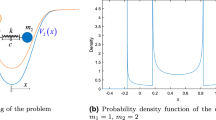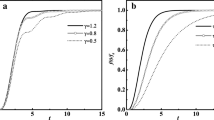Abstract
Within the numerical simulation method applied to the Langevin equation, the escape problem of particle moving in the truncated quartic potential driven by two types of correlated Lévy noise, i.e., Ornstein–Uhlenbeck Lévy noise and harmonic velocity Lévy noise, is studied. The dependence of the escape rate on the noise intensity parameter, the Lévy index, the noise correlation, and the particle mass is discussed. Results reveal that the correlation, especially the strong correlation, makes the power-law exponent \(\alpha (\mu )\) and the inverse coefficient \(\text {lnc}(\mu )\) present significantly different dependences on the Lévy index \(\mu \). Especially, because of the distinctly opposite correlation properties of these two noises, the escape rate shows entirely opposite phenomena, i.e., the escape rate of the particles driven by the Ornstein–Uhlenbeck Lévy noise decreases with correlation increasing, whereas the escape rate of the particles driven by the harmonic velocity Lévy noise increases instead. Since the particle becomes heavy with m increasing, for the two types of correlated Lévy flight, the escape rates both decrease monotonically with particle mass increasing.








Similar content being viewed by others
Data Availability Statement
This manuscript has no associated data or the data will not be deposited. [Authors’ comment: The data supporting the findings of this study are available from the corresponding author upon reasonable request.]
References
M. de Jager, F.J. Weissing, P.M.J. Herman, B.A. Nolet, J. van de Koppel, Science 332, 1551 (2011)
F. Lenz, T.C. Ings, L. Chittka, A.V. Chechkin, R. Klages, Phys. Rev. Lett. 108, 098103 (2012)
P. Barthelemy, J. Bertolotti, D.S. Wiersma, Nature 453, 495 (2008)
D.A. Kessler, E. Barkai, Phys. Rev. E 108, 230602 (2012)
M.J. Saxton, K. Jacobson, Annu. Rev. Biophys. Biomol. Struct. 26, 373 (1997)
I. Bronstein, Y. Israel, E. Kepten, S. Mai, Y. Shav-Tal, E. Barkai, Y. Garini, Phys. Rev. Lett. 103, 018102 (2009)
I.M. Sokolov, J. Mai, A. Blumen, Phys. Rev. Lett. 79, 857 (1997)
M.A. Lomholt, T. Ambjömsson, R. Metzler, Phys. Rev. Lett. 95, 260603 (2005)
Y. Sagi, M. Brook, I. Almog, N. Davidson, Phys. Rev. Lett. 108, 093002 (2012)
A.A. Dubkov, B. Spagnolo, V.V. Uchaikin, Int. J. Bifurca. Chaos 18, 2649 (2008)
P. Imkeller, I. Pavlyukevich, J. Phys. A: Math. Gen. 39, L237 (2006)
T. Koren, A.V. Chechkin, J. Klafter, Phys. A 379, 10 (2007)
T. Koren, M.A. Lomholt, A.V. Chechkin, J. Klafter, R. Metzler, Phys. Rev. Lett. 99, 160602 (2007)
A.A. Dubkov, B. Spagnolo, Eur. Phys. J. Special Topics 216, 31 (2013)
A.A. Dubkov, A.A. Kharcheva, Europhys. Lett. 113, 30009 (2016)
A.A. Kharcheva, A.A. Dubkov, B. Dybiec, B. Spagnolo, D. Valenti, J. Stat. Mech. , 054039 (2016)
B. Dybiec, E. Gudowska-Nowak, E. Barkai, A.A. Dubkov, Phys. Rev. E 95, 052102 (2017)
A.A. Dubkov, B. Dybiec, B. Spagnolo, A. Kharcheva, C. Guarcello, D. Valenti, Phys. Rev. E 102, 042142 (2020)
J.D. Bao, H.Y. Wang, Y. Jia, Y.Z. Zhuo, Phys. Rev. E 72, 051105 (2005)
A.V. Chechkin, O.Y. Sliusarenko, R. Metzler, J. Klafter, Phys. Rev. E 75, 041101 (2007)
A.V. Chechkin, V.Y. Gonchar, J. Klafter, R. Metzler, EPL 72, 348 (2005)
P.D. Ditlevsen, Phys. Rev. E 60, 172 (1999)
Z.W. Bai, M. Hu, Phys. A 428, 332 (2015)
B. Dybiec, E. Gudowska-Nowak, P. Hänggi, Phys. Rev. E 75, 021109 (2007)
M. Bier, Phys. Rev. E 97, 022113 (2018)
T. Srokowski, Phys. Rev. E 85, 021118 (2012)
V.P. Bongolan-Walsh, J.Q. Duan, T. Ózgókmen, Commun. Nonlinear. Sci. Numer. Simulat. 13, 1627 (2008)
I. Eliazar, J. Klafter, Phys. A 376, 1 (2007)
A. Weron, M. Magdziarz, Phys. Rev. Lett. 105, 260603 (2010)
M. Magdziarz, Phys. A 387, 123 (2008)
I. Eliazar, J. Klafter, J. Phys. A: Math. Theor. 40, F307 (2007)
I. Eliazar, J. Klafter, Phys. Rev. E 75, 031108 (2007)
F.F. Li, X.S. Chen, J. Liu, J. Stat. Mech. 083209(2020)
P. Garbaczewski, R. Olkiewica, J. Math. Phys. 41, 6843 (2000)
R. Hintze, I. Pavlyukevich, Bernoulli 20, 265 (2014)
A. Wylomaniska, A. Chechkin, J. Gajda, I.M. Sokolov, Phys. A 421, 412 (2015)
M. Hu, J.M. Zhang, J.D. Bao, J. Chem. Phys. 146, 204103 (2017)
F.F. Li, P. Zhu, J.D. Bao, X.S. Chen, J. Liu, J. Stat. Mech. 043210(2021)
I. Eliazar, J. Klafter, J. Stat. Phys. 119, 165–196 (2005)
A.A. Dubkov, B. Spagnolo, Fluct. Noise Lett. 5, L267 (2005)
S. Jespersen, R. Metzler, H.C. Fogedby, Phys. Rev. E 59, 2736 (1999)
L. Schimansky-Geier, C. Zlicke, Z. Phys. B 79, 451 (1990)
M.I. Dykman, R. Mannella, Phys. Rev. E 47, 3996 (1993)
J.D. Bao, Y.L. Song, Q. Ji, Y.Z. Zhuo, Phys. Rev. E 72, 011113 (2005)
J.D. Bao, P. Hänggi, Y.Z. Zhuo, Phys. Rev. E 72, 061107 (2005)
J.M. Chambers, C.L. Mallows, B.W. Stuck, J. Am. Stat. Assoc. 71, 340 (1976)
R. Weron, Statist. Probab. Lett. 28, 165 (1996)
D. Fulger, E. Scalas, G. Gemmano, Phys. Rev. E 77, 021122 (2008)
Z.W. Bai, M. Hu, Phys. A 479, 91 (2017)
Acknowledgments
This work is supported by the National Natural Science Foundation of China under Grant No. 11605003, the Support Project of High-level Teachers in Beijing Municipal Universities Under Grant No. CIT&TCD201904034, and 2021 Postgraduate Research Capacity Enhancement Program of BTBU.
Author information
Authors and Affiliations
Contributions
P. Zhu carried out the calculations. J. Liu and P. Zhu designed and wrote the paper. All authors contributed to the scientific discussions and the preparation of the manuscript, and approved the final version of the manuscript.
Corresponding author
Appendices
Appendix A: Numerical algorithm of OULN
The OULN \(\xi (t)\) can be generated from the generalized OULP, the detailed introduction of the numerical algorithm is presented in our previous work [33]. Here we present a brief introduction.
Solving Eq. (1) by an inverse Laplace transform, we have
and
Introducing \(y=\frac{1}{\tau _c}e^{-\frac{t+\Delta {t}}{\tau _c}}\int _{t}^{t+\Delta {t}}e^{\frac{s}{\tau _c}}L(s)\,ds\), we have a characteristic function P(k),
Hence, we have
in which \(L_{\mu }\) is a symmetric Lévy \(\mu \)-stable random number [46,47,48],
in which \(\phi = \pi (\nu -1/2)\) and \(u,\nu \in (0,1)\) are independent uniform random numbers.
Finally, the numerical simulation of the Langevin equation (10) is
Appendix B: Numerical algorithm of HVLN
The numerical algorithm of the Langevin equation driven by HVLN can be executed by the following process. Combining Eqs. (7), (8), and (10), we have
and the numerical calculations can be executed by
in which \(L_{\mu }\) is generated from Eq. (A5).
Rights and permissions
About this article
Cite this article
Zhu, P., Zhang, C. & Liu, J. Barrier escape from a truncated quartic potential driven by correlated Lévy noises with opposite correlation. Eur. Phys. J. B 94, 154 (2021). https://doi.org/10.1140/epjb/s10051-021-00166-z
Received:
Accepted:
Published:
DOI: https://doi.org/10.1140/epjb/s10051-021-00166-z




